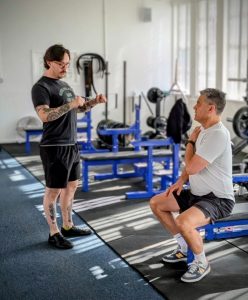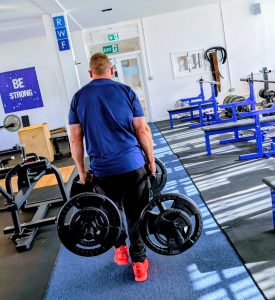Stress Hormones and Strength Training
Modern life can be stressful. Between work deadlines, family responsibilities, lack of sleep and a constant flood of 24/7 information, it’s not a huge surprise so many people arrive at the gym already running on fumes.
That’s where the problem often begins, because when stress outside the gym is high, and training stress is piled on top, your body can quickly hit the wall.
Understanding how your stress hormones work can make the difference between steady progress and constant banging your head against the wall.

We have many clients with busy, stressful lives – proper training shouldn’t add to that stress
The Role of Stress Hormones: Cortisol and Adrenaline
Your body’s stress response is designed to protect you. When you face a challenge, whether that’s a hard workout, a last-minute meeting, or even a lack of sleep, two key hormones kick in:
-
Adrenaline. The ‘fight or flight’ hormone. It’s released rapidly from the adrenal medulla and acts within seconds, raising heart rate, blood pressure and blood glucose to prepare your muscles for action. In training, this helps you focus and produce force. It’s what allows you to keep going through a tough set or hit a PB.
-
Cortisol. The longer-term stress hormone. Released from the adrenal cortex, it helps regulate your metabolism by increasing the availability of glucose and amino acids for energy. In short bursts, this helps performance and recovery. But when cortisol stays elevated chronically, due to poor sleep, under-eating, psychological stress, or overtraining, it starts to break down muscle tissue, suppress immune function, and blunt your ability to build new strength.
These hormones are part of the hypothalamic–pituitary–adrenal (HPA) axis, a delicate feedback system between your brain and adrenal glands. It’s meant to spike briefly, then settle once the stressor passes.
When that balance is lost, and when adrenaline and cortisol remain high, the body never fully returns to a “rest and rebuild” state.
Training Hard vs. Training Smart
When you’ve already been under pressure all day, your nervous system is in a heightened state — the sympathetic nervous system, which drives that ‘fight or flight’ mode, stays dominant. Training hard on top of this can push you further into sympathetic overdrive.
The other side of the equation, the parasympathetic nervous system, responsible for rest, digestion and repair, struggles to do its job. That’s when fatigue starts to creep in, even if you feel you’re doing everything right.
You may still feel productive, but your hormones, joints, and nervous system are experiencing something very different. Over time, you’ll notice:
-
Trouble sleeping, even when you’re exhausted
-
Stubborn body fat (especially around the midsection, where cortisol receptors are dense)
-
Dips in strength or motivation
-
Constant soreness or niggling injuries
These are classic signs that your stress hormones are doing too much of the (pun intended) heavy lifting, and that recovery methods aren’t keeping up.

There’s no reason not to train hard – we just don’t want to add unnecessary stress
Managing Stress for Better Gains
You don’t need to train less, you need to train appropriately. A good strength programme recognises that recovery is when a huge chunk of your progress actually happens.
Here’s how to balance things out:
Vary your intensity. Training is a stressor, but stress is what drives adaptation. The key is managing the dose. Not every session should be maximal. Rotate high-intensity days with moderate or lower-load work to allow your nervous system and hormones to normalise.
Prioritise sleep and nutrition. Sleep drives growth hormone release and reduces cortisol. Adequate protein and carbohydrates support muscle repair and keep blood glucose stable, preventing unnecessary cortisol spikes.
Use strength training as a stress outlet, not an extra stressor. On high-stress weeks, lower training volume or intensity slightly. You’ll recover better and make more progress long-term. A week of taking a slight step back usually reaps rewards in the following few weeks.
Breathe and reset. Deep breathing, meditation or simply slowing your breathing between sets can shift your body back toward a parasympathetic state, helping cortisol drop post-training. Be conscious of trying to actually breathe deeply – you can often feel your heartbeat slowing and calm taking over within 20-30 seconds.
Trust the process. Consistency beats intensity every time. The body thrives on adaptation, not shock. You’ll make more progress with 3 balanced sessions a week for 6 months than 6 all-out ones for 3 weeks. A line my clients will have heard endlessly is ‘stimulate, don’t annihilate’.
How can a personal trainer help with this?
Strength training should make your life better, not leave you more drained. At Real World Fitness, we build programmes that respect the fact you’ve got a job, a family, and a full plate outside of training.
We’re not scientists or endocrinologists . We’re not going to pretend we understand the precise interaction of all your body’s complex systems, and if we think you’re at a point that you need help beyond some training and lifestyle, we’ll help refer to you to proper, medical help.
We can and will, however, help you get strong, stay consistent, and manage the stress that comes with being human, not just the stress of throwing some metal around in the gym.

Get outside and breathe occasionally – it can often do more for your lifting than actual lifting!
FAQ: Stress Hormones & Strength Training
Does high cortisol ‘kill’ muscle growth?
No. Acute cortisol spikes during hard sets are normal and even helpful for mobilising fuel. Problems arise when cortisol stays chronically elevated (poor sleep, under-eating, constant life stress and maximal training). Chronically high levels can increase protein breakdown and blunt muscle-protein synthesis, slowing gains, but not stopping them entirely.
Can lifting weights lower stress in the long run?
Yes, when the dose is right. Resistance training creates a short-term stress response (adrenaline/cortisol up), followed by a rebound toward balance. That means improved insulin sensitivity, better sleep quality, and a calmer baseline.
Should I avoid heavy lifting when I’m stressed?
Not necessarily. Keep some heavy work, but cap it at RPE 7–8, limit failure sets, and maybe drop off a little total volume. Think ‘leave 1–3 reps in the tank’ and prioritise technique over anything else.
How do sleep and food change my cortisol response?
Lack of sleep elevates daytime cortisol and impairs recovery. Adequate protein supports repair; carbohydrates around training help control the cortisol response by maintaining blood glucose and glycogen. Investigating creatine use might help with the effects of missed sleep.
Does fasted training spike cortisol?
Fasted morning sessions can raise cortisol more than fed training. It isn’t inherently bad, but fuelling with some protein + carbs pre or post-workout generally improves performance and recovery for busy lifters.
What’s a sensible deload?
Every 6–8 weeks (or when life stress climbs), reduce volume by around 30–50% and intensity by 5–10% for 5–7 days. This lets the HPA axis and nervous system recover while keeping movement patterns practiced, meaning when you can step it up again you’re not rusty.
How do I know I’m overcooking it?
Persistent poor sleep, flat motivation, declining bar speeds, elevated resting heart rate, frequent colds/niggles, and stalled lifts are red flags that sympathetic drive is dominating and recovery is lagging.
Will stress make me store belly fat?
Chronic stress and sleep loss are linked with central fat gain, partly via cortisol and appetite changes. It’s multifactorial (diet/activity matter most), but managing stress and sleep helps your body composition efforts.
What weekly structure works for a busy schedule?
Three 45–60 min full-body sessions (A/B rotation), optional short conditioning or walks on off-days, and daily ‘parasympathetic breaks’ (breathing, light mobility, outdoor walks). Progress loads or reps modestly each week.
Do breathwork and walks really affect recovery?
Yes. Slow nasal breathing and easy walking increase parasympathetic activity, lower perceived stress, and can improve HRV — all supportive of better lifting and adaptation. Most people’s clarity of thought improves from a simple 20 minute outdoor walk.
Book a free Personal Training session today
If you’re in Colwick, Netherfield, West Bridgford, or anywhere else in Nottingham and you’re considering personal training, now’s your chance!
Book your FREE personal training session today and turn your fitness dreams and transformation goals into an achievable reality.
Don’t just take our word for it; feel the difference in guidance, expertise, and motivation. Nottingham residents, your journey to the best version of yourself starts with just one session.
Sign up to the RWF newsletter




